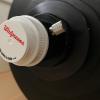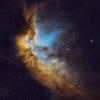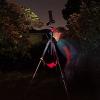Hello everyone,
After a long pause (9 years), my commitments allow me to get back into the hobby of astrophotography!
I've got a Skywatcher Equinox 120ED (900 FL), AM5 ZWO mount and will be using a DSLR Canon EOS500D to start off with. If all goes well, I'll be changing to a dedicated CCD cooled camera.
My main issue right now has to do with selection of a suitable guide scope and guide camera. I've done a lot of research on the topic, seen a lot of videos from popular youtubers, but there seems to be a lot of contradicting information that's only making things more confusing for me.
My understanding is that there is a general rule of thumb that the guidescope should have a focal length (FL) 1/3 of the primary imaging scope. In my case, this is 300mm since the imaging scope has a FL of 900mm.
I've also read that today's advanced guide cameras change these rules, allowing us to use guidescopes with shorter focal lengths, but this is after taking into consideration all your equipment according to Astronomy tool's guidescope suitability calculator (https://astronomy.to...ope_suitability), where the imaging/guiding ratio should be kept to as close to 1:3.
My question is what would be the best guidescope/guide camera for my current setup?
I'd also like to take into account that I'm likely to switch from DSLR to CCD (colour) imaging later on. Possible recommendations I've seen from youtube videos include the ASI 120mm and ASI 220mm, but I'm not sure what would be the most ideal guidescope.
If you have a similar setup, I'd really love to hear about your experience and recommendations as I don't want to end up wasting money on something that either won't work for me or is an overkill.
To help further, I'm considering of setting a budget of around $750AUD and do not mind purchasing second-hand equipment.
Thank you very much and I look forward to your replies!
Chris.























